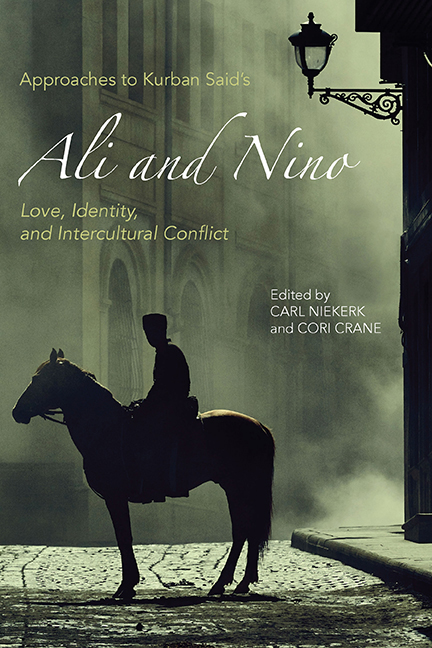Book contents
- Frontmatter
- Contents
- Acknowledgments
- Notes on Editions of and References to Ali and Nino
- Introduction: Ali and Nino as World Literature
- 1 Ali and Nino: The Novel as/of Cultural Translation
- 2 Crossing Borders, Crossing Disciplines: Ali and Nino in the Twenty-First Century
- 3 Glowing Rubies and Persian Daggers: The Role of Persian Poetry in Ali and Nino
- 4 Gendered Stereotypes and Cross-Cultural Moral Values through the Eyes of Kurban Said
- 5 Orientalist Itineraries: Cultural Hegemony, Gender, Race, and Religion in Ali and Nino
- 6 Gendered Conflicts in Muslim and Christian Cultures: Honor (and Shame) in Ali and Nino
- 7 Love and Politics: Retelling History in Ali and Nino and Artush and Zaur
- 8 “Herr Professor, Please: We'd Rather Stay in Asia”: Ali Khan Shirvanshir and the Spaces of Baku
- 9 The Female Body and the Seduction of Modernity in Ali and Nino
- 10 Seeing the Unseen: Symbolic Writing in Ali and Nino
- 11 Ali and Nino and Jewish Questions
- 12 Between Orientalism and Occidentalism: Culture, Identity, and the “Clash of Civilizations” in Ali and Nino
- Works Cited
- Notes on the Contributors
- Index
Introduction: Ali and Nino as World Literature
Published online by Cambridge University Press: 30 August 2017
- Frontmatter
- Contents
- Acknowledgments
- Notes on Editions of and References to Ali and Nino
- Introduction: Ali and Nino as World Literature
- 1 Ali and Nino: The Novel as/of Cultural Translation
- 2 Crossing Borders, Crossing Disciplines: Ali and Nino in the Twenty-First Century
- 3 Glowing Rubies and Persian Daggers: The Role of Persian Poetry in Ali and Nino
- 4 Gendered Stereotypes and Cross-Cultural Moral Values through the Eyes of Kurban Said
- 5 Orientalist Itineraries: Cultural Hegemony, Gender, Race, and Religion in Ali and Nino
- 6 Gendered Conflicts in Muslim and Christian Cultures: Honor (and Shame) in Ali and Nino
- 7 Love and Politics: Retelling History in Ali and Nino and Artush and Zaur
- 8 “Herr Professor, Please: We'd Rather Stay in Asia”: Ali Khan Shirvanshir and the Spaces of Baku
- 9 The Female Body and the Seduction of Modernity in Ali and Nino
- 10 Seeing the Unseen: Symbolic Writing in Ali and Nino
- 11 Ali and Nino and Jewish Questions
- 12 Between Orientalism and Occidentalism: Culture, Identity, and the “Clash of Civilizations” in Ali and Nino
- Works Cited
- Notes on the Contributors
- Index
Summary
KURBAN SAID's NOVEL Ali and Nino, first published in German in 1937, is not the kind of text to which one typically finds references in books on literary history, not even in the most comprehensive volumes. The novel is hard to categorize. It is, for instance, not clear to which national literature or cultural tradition the text should be assigned. Although the novel was originally published in German and with a publishing house specializing in German-language texts, the E. P. Tal Verlag in Vienna, its author's decision to go by the alias “Kurban Said” suggests to readers that his own native language might not be German. The geographical setting of the book—Azerbaijan and Persia during the first two decades of the twentieth century—reinforced this impression that the text's author might not be from a German-speaking country. Rather, the author must be a newcomer on the literary scene. His chosen alias was perhaps meant to provide the text with a certain authenticity: most likely the book was written, one could stipulate, by someone with a personal history in Azerbaijan or Persia in the early twentieth century. Above all, the alias suggested a mystery: Why this novel in German? And why was it published in Vienna? Moreover, in hindsight, the date of publication, 1937, is intriguing: Europe at the time was, as we know now, at the brink of a new and exceptionally violent world war. Ali and Nino indeed takes up the themes of violence and destruction as well, but at the same time suggests an alternative to this world of violence. Above all, Ali and Nino is a love story about two people from divergent cultural and religious backgrounds who in spite of their many differences find each other and, at least for a while, are able to create a happy life together.
For a long time Ali and Nino was what the Germans call a Geheimtipp : only known to and appreciated by a small group of insiders with either a more than superficial interest in the literature of exile or exceptional knowledge of the region (i.e., Azerbaijan, Persia, and the Middle East more generally)—areas about which Kurban Said wrote in both Ali and Nino and his subsequent novel, The Girl from the Golden Horn (first published in German also by the Vienna Tal Verlag in 1938, one year after Ali and Nino).
- Type
- Chapter
- Information
- Approaches to Kurban Said's Ali and NinoLove, Identity, and Intercultural Conflict, pp. 1 - 14Publisher: Boydell & BrewerPrint publication year: 2017

